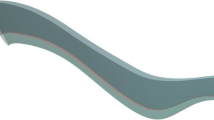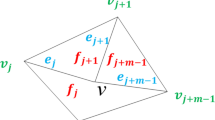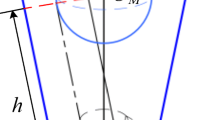Abstract
Selecting the appropriate cutter size and determining the noninterference tool orientation are the key steps in planning the four-axis machining of complex channel parts. In this paper, based on the invariance property of isometric transformation and the function of the minimum distance between surfaces, a nonlinear numerical optimization method is proposed to accurately solve the noninterference critical tool orientation and maximum taper angle of the conical cutter. Furthermore, the optimization method for the maximum taper angle of the conical cutter can handle the different cases, whether the tool orientation is preset or not. Firstly, the basic theory of the proposed optimization method for the conical cutter is given. Secondly, the optimization method for calculating the noninterference tool orientation is provided. Thirdly, the local optimization method for the taper angle of a conical cutter with the tool orientation preset, and the global optimization method for the maximum taper angle of the conical cutter are provided. The conical cutter solved by the local optimization method can reach critical state with a single constraint surface, but the conical cutter solved by the global optimization method can reach critical state with multiple constraint surfaces. Finally, the proposed method is verified by the simulation experiments. The results show that the provided method accurately calculates the result for the noninterference tool orientation of a given conical cutter and the max taper angle of the conical cutter. Furthermore, it proves that the collaborative optimization strategy of the tool orientation and cutter taper angle used in the global optimization method is much better for the max taper angle of the conical cutter.





























Similar content being viewed by others
References
Wu BH, Chen ZC, Luo M, Zhang DH, Han FY (2019) An automated approach to calculating the maximum diameters of multiple cutters and their paths for sectional milling of centrifugal impellers on a 4½-axis CNC machine. Chin J Aeronaut 32(4):1030–1039
Chang ZY, Wen J, Chen ZC, Zhang DH (2017) A reliable and efficient approach to numerically controlled programming optimization for multiple largest tools cutting blisks patch by patch in the blisks’ four-axis rough machining. J Manuf Sci Eng 136(9):091013
Zhang WB, Ren JX, Liang YS (2020) Optimization of the cutter size and tool orientation for reaching the critical state with multi-constraints in deep and narrow channel parts machining. Int J Adv Manuf Technol 110:1969–2001
Zhang WB, Ren JX (2020) Improving the machining dynamics performance and efficiency for complex channel part manufacturing by planning the tool orientations and feed rate sequence. Int J Adv Manuf Technol 107:3663–3689
Zheng G, Zhu LM, Bi QZ (2012) Cutter size optimization and interference-free tool path generation for five-axis flank milling of centrifugal impellers. Int J Prod Res 50(23):6667–6678
Li XY, Ren JX, Tang K, Liang YS, Liu CL (2019) Optimization of cutter profile for achieving maximum stiff-ness in five-axis milling of deep and narrow channel parts. J Manuf Proc 47:541–555
Li XY, Ren JX, Tang K, Zhou YK (2019) A tracking-based numerical algorithm for efficiently constructing the feasible space of tool axis of a conical ball-end cutter in five-axis machining. Comput Aided Des 117:102756
Wang YP, Xu JT, Sun YW (2021) Tool orientation adjustment for improving the kinematics performance of 5-axis ball-end machining via CPM method. Robot Comput Integr Manuf 68: 102070.1–102070.12
Li XY, Ren JX, Liang YS, Tian XR (2014) Tool axis planning for five-axis machining of complex channel parts. Acta Aero ET Astro Sin 44(10):1920–1940
Bi QZ, Wang YH, Ding H (2010) A GPU-based algorithm for generating collision-free and orientation-smooth five-axis finishing tool paths of a ball-end cutter. Int J Prod Res 48(4):1105–1124
Wang J, Luo M, Zhang DH (2018) A GPU-Accelerated approach for collision detection and tool posture modification in multi-axis machining. IEEE Access 6:35132–35142
Xiao QB, Wan M, Zhang WH, Yang Y (2022) Tool orientation optimization for the five-axis CNC machining to constrain the contour errors without interference. J Manuf Proc 76:46–56
Li C, Xu K, Tang K (2015) Collision-free tool orientation optimization in five-axis machining of bladed disk. J Comput Des Eng 2(4):197–205
Liang Y, Zhang D, Ren JX, Li XY (2016) Accessible regions of tool orientations in multi-axis milling of blisks with a ball-end mill. Int J Adv Manuf Technol 85(5–8):1887–1900
ZW Wang, XJ Lin, YY Shi (2020) Efficiently constructing collision-free regions of tool orientations for holder in five-axis machining of blisk. Chinese J Aeronaut
Zhu LM, Ding H, Xiong YL (2012) Simultaneous optimization of tool path and shape for five-axis flank milling[J]. Comput Aided Des 44(12):1229–1234
Zhu LM, Zhang XM, Zheng G, Ding H (2009) Analytical expression of the swept surface of a rotary cutter using the envelope theory of sphere congruence. J Manuf Sci Eng 131(4):041017
Bo P, Bartoň M, Plakhotnik D, Denys P, Helmut P (2016) Towards efficient 5-axis flank CNC machining of free-form surfaces via fitting envelopes of surfaces of revolution. Comput Aided Des 79:1–11
Meng FJ, Chen ZT, Xu RF, Lin X (2014) Optimal barrel cutter selection for the CNC machining of blisk. Comput Aided Des 53:36–45
Yan DQ, Zhang DH, Luo M (2015) Optimization of barrel cutter for five-axis flank-milling based on approximation of tool envelope surface[J]. Comput Aided Des Appl 12(6):717–722
Jung-Woo C, Yi-King C, Kim M-S, Wang W (2011) Computation of the minimum distance between two bézier curves/surfaces. Comput Graph 35(3):677–684
He P, Zhang CM, Zhou JB, Ma YL (2010) Calculating minimum distance between two NURBS objects. J Comput Aided Des Comput Graphics 22(8):1344–1351
Liu H, Tang YH, Liao WH (2003) Minimum distance between two biquadratic NURBS surfaces. J Comput Aided Des Comput Graph 15(10):1298–1302
Mathews JH, Fink KD (2004) Numerical methods using MATLAB. Pearson
Acknowledgements
We would like to appreciate Professor Junxue Ren for his leadership, and the constructive opinions of Dr. Jinhua Zhou significantly improved the paper.
Funding
This work is supported by the National Science and Technology Major Project (J2019-VII-0001–0141), the National Natural Science Foundation of China (Grant No. 52075451), and the Aeronautical Science Foundation of China (Grant No. 2019ZE053008), and the China Post-doctoral Science Foundation (Grant No. 2020M683551).
Author information
Authors and Affiliations
Contributions
All authors contributed to the study conception and design. The initial idea of this paper was provided by Junxue Ren. The improvement suggestion was given by Jinhua Zhou. The algorithm design, data collection, and analysis were performed by Wenbo Zhang. The first draft of the manuscript was written by Wenbo Zhang and all authors commented on previous versions of the manuscript. All authors read and approved the final manuscript.
Corresponding author
Ethics declarations
Competing interests
The authors declare no competing interests.
Additional information
Publisher's note
Springer Nature remains neutral with regard to jurisdictional claims in published maps and institutional affiliations.
Rights and permissions
Springer Nature or its licensor (e.g. a society or other partner) holds exclusive rights to this article under a publishing agreement with the author(s) or other rightsholder(s); author self-archiving of the accepted manuscript version of this article is solely governed by the terms of such publishing agreement and applicable law.
About this article
Cite this article
Zhang, W., Ren, J. & Zhou, J. Noninterference tool orientations and maximum taper angles of conical cutters in 4-axis milling of complex channel parts. Int J Adv Manuf Technol 127, 4357–4385 (2023). https://doi.org/10.1007/s00170-023-11711-8
Received:
Accepted:
Published:
Issue Date:
DOI: https://doi.org/10.1007/s00170-023-11711-8




